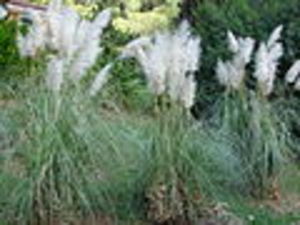Some plant problems you create for yourself. Others you inherit. One that came with our property when we bought it 20-plus years ago was an infestation of pampas grass.
At first glance, pampas grass is quite attractive. It is large, up to 10 feet in height, and is kind of an oversized fountain grass with feathery seed plumes. The perennial grass native to Brazil, Argentina and Chile tends to grow in large clumps, and it was all over the hills in back of our house where little else would grow.
However, we were soon to find out that pampas grass is almost impossible to kill, and its long, drooping leaves have razor-sharp edges that can deliver a nasty cut. The leaves and plumes soon littered our patio on windy days. And every spring, more little pampas grass plants came up all over the hills.
Pampas grass is another plant introduced as an ornamental shrub to California, where it is now wreaking havoc on the environment. It’s quite suited to dry, windswept pampas of South America. But it’s spread like a weed along the West Coast, and is very difficult to get rid of once it’s established.
Two species of pampas grass can be found in California wildlands. There is Cortaderia selloana (true pampas grass) and Cortaderia jubata (jubata grass or Andean pampas grass). It can be found most commonly along roadsides and on dunes, coastal bluffs, and rocky outcrops.
Like other invasive, non-native species, pampas grass crowds its environment so ferociously that there is little room left for native plants. Once it takes over wildlands, it forces out plants that would otherwise feed the birds and animals that live in the environment. According to Wikipedia, each plant is able to produce over a million seeds during its lifetime. Not only is pampas grass a problem in California, but also Hawaii, and it is also a pest species in New Zealand and South Africa.
No wonder. It’s very, very hard to get rid of. Pampas grass sends a huge taproot into the soil that is murder to cut. The plant itself is also very tough, with fibrous stems and leaves that resist most shears. We had to hire men with chainsaws to get rid of some of ours. The resulting debris had to be removed carefully, and with long sleeved shirts and gloves on, so that the leaves couldn’t cut us.
The plumes of pampas grass send millions of seeds into the vicinity with just the touch of a gentle breeze, and each fall the plants produce more seed plumes. Many people cut the plumes and take them home, because they’re pretty, but this spreads the seeds even further.
Digging it up, if you can, is the best way to get rid of it. If you take out the plants while they’re small, this is no big deal. Large, established plants are very hard to kill. Because the mature plants can be so big and heavy, a recommended method is to slip a choker cable around the plant’s base and pull it out with a winch.
Sometimes, repeated sprays of an herbicide, such as Roundup, can eliminate it, although this often takes a while. Like years.
We still have pampas grass on our hill, although we did get rid of some of it. We are living with six or seven large plants that don’t seem to want to die. Every spring, I go around and dig up the baby plants and get rid of them. Every fall, we carefully cut the plumes and dispose of them so that the seeds can’t be spread.
What can you do? If you are a property owner, try to eliminate pampas grass, or at least control its spread in the ways I’ve described. You can also get involved with your local native plant society, which often has weed-pulling parties to stamp out noxious vegetation.
Don’t encourage the spread of pampas grass by deliberately planting it, or waving the seed plumes around. And tell other people what they can do to get rid of it.



